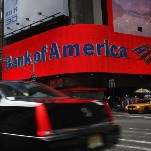American Apparel's Plans For Recession Success: More Sex, Please
LatestDov Charney, the CEO so skeevy he ought to be an R. Crumb character, is in the news again. His highly leveraged company is weathering the downturn, but only barely.
Relatively speaking, a 3% increase in same-store sales for the month of December 2008 isn’t terrible only in the sense that it’s not actually a decline — such as that experienced by the retail sector as a whole, where same-store sales shrank 0.9%, and by individual competitors like Abercrombie & Fitch and the Gap, whose December sales were down by over 20% on 2007’s numbers. But let’s not forget it’s also not stunning. The previous year, American Apparel managed to raise December same-store sales by 37%, which makes 3% look flat. And it’s simply not true that chain stores are uniformly blighted: Aeropostale and the Buckle’s same-store sales rose 12% and 13.5% for December. If there’s anyone “bucking the trend,” it’s those players, not Dov Charney, whose stock price is trading right now at $2.06, off a 52-week high of $13.25. (Or, I suppose, up from a 52-week low of $1.55, depending on how you look at it.)
For once, the company’s financial situation is in the news, instead of its sexual sexy sexing ad campaigns or the sexifying sexual harassing antics of its founder. (Not that either of those things are likely to change — the company considers the former a key to its future growth, and maintains a $20 million insurance policy just in case the latter should happen to recur.) The American Apparel bottom line is the subject of a good, long, detailed story in Women’s Wear Daily; reading it, I was reminded of Warren Buffett’s quote about only finding out who’s been swimming naked when the tide goes out.
American Apparel’s early financial wackiness — a CEO who was prone to spending lavishly on inessentials like apartments and vibrators for favored underlings, a hamfisted, starry-eyed approach to expansion that saw 260 stores open in just a few years (for one of those years, 2005, the company did not actually find the time to replace the CFO who died of a [coincidental?] heart attack, preferring to delegate bookkeeping to young staffers), and a factory that, once it was properly managed, increased daily production from 32,000 pieces to 250,000 pieces without adding staff, all financed by a phenomenal debt load — meant that when the company went public, it could not do so via a traditional initial public offering. Instead, it was quietly bought by a shell company, Endeavour Acquisitions, run by a vaguely dodgy D.C. businessman and a financier from New Zealand, who took the company public while avoiding the scrutiny and regulatory oversight of an IPO. It was a way of buying time; things weren’t going to change overnight — on the eve of the deal, a true to form Charney told a Wall Street Journal reporter the company’s eventual choice for its new CFO was “a complete loser” and a real stickler for details — but the idea was American Apparel would slowly get its house in order. Then the economy as we know it more or less ended, and now WWD reports their balance sheet looks like this:
-

-

-

-

-

-

-

-

-

-

-

-

-

-

-

-

-

-

-

-

-

-

-

-

-

-

-

-

-

-

-

-

-

-

-

-

-

-

-

-








































